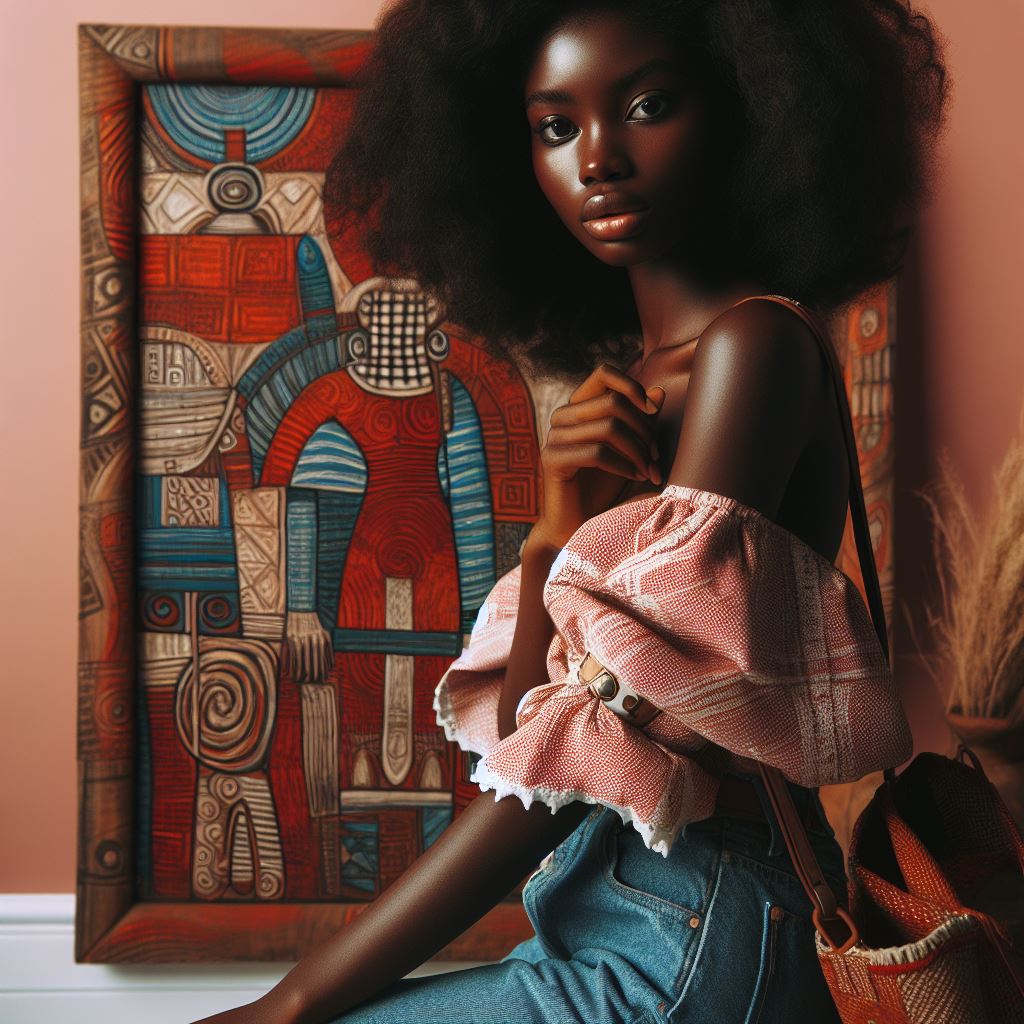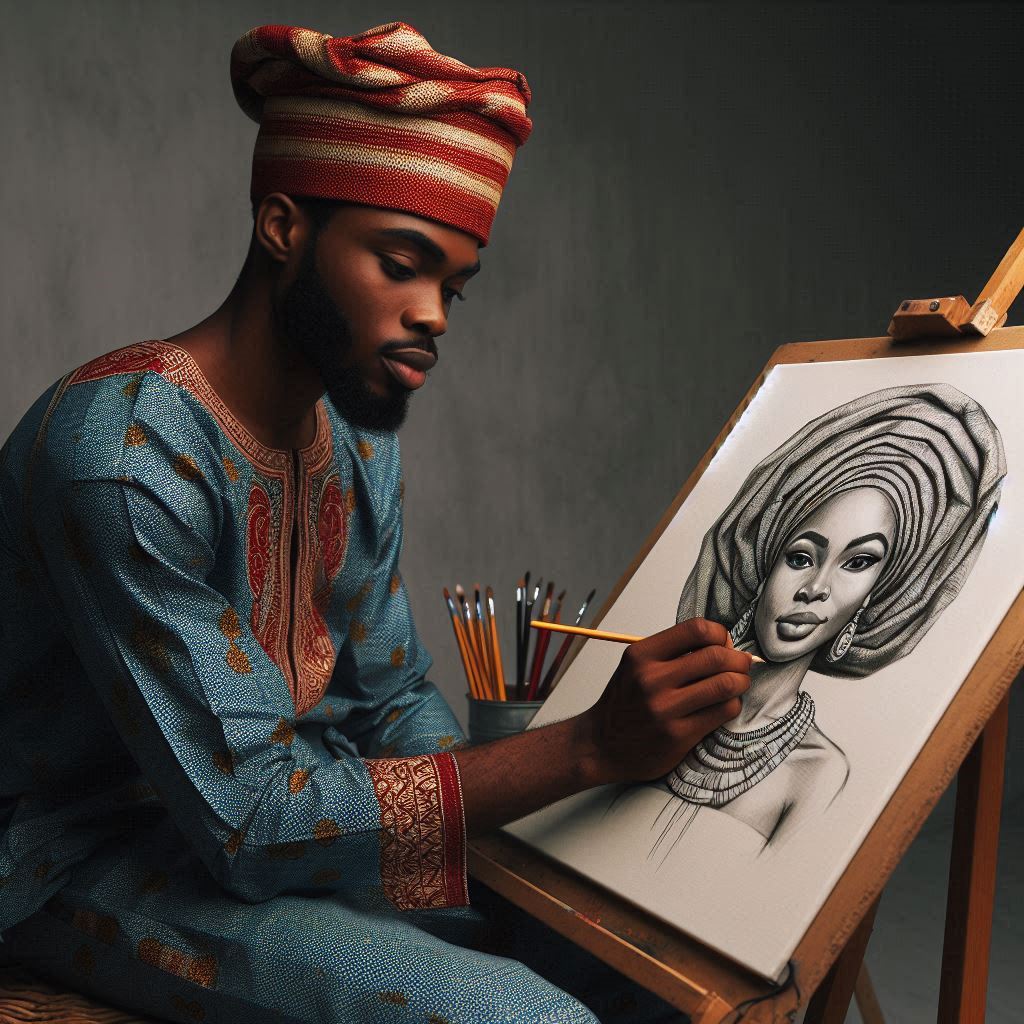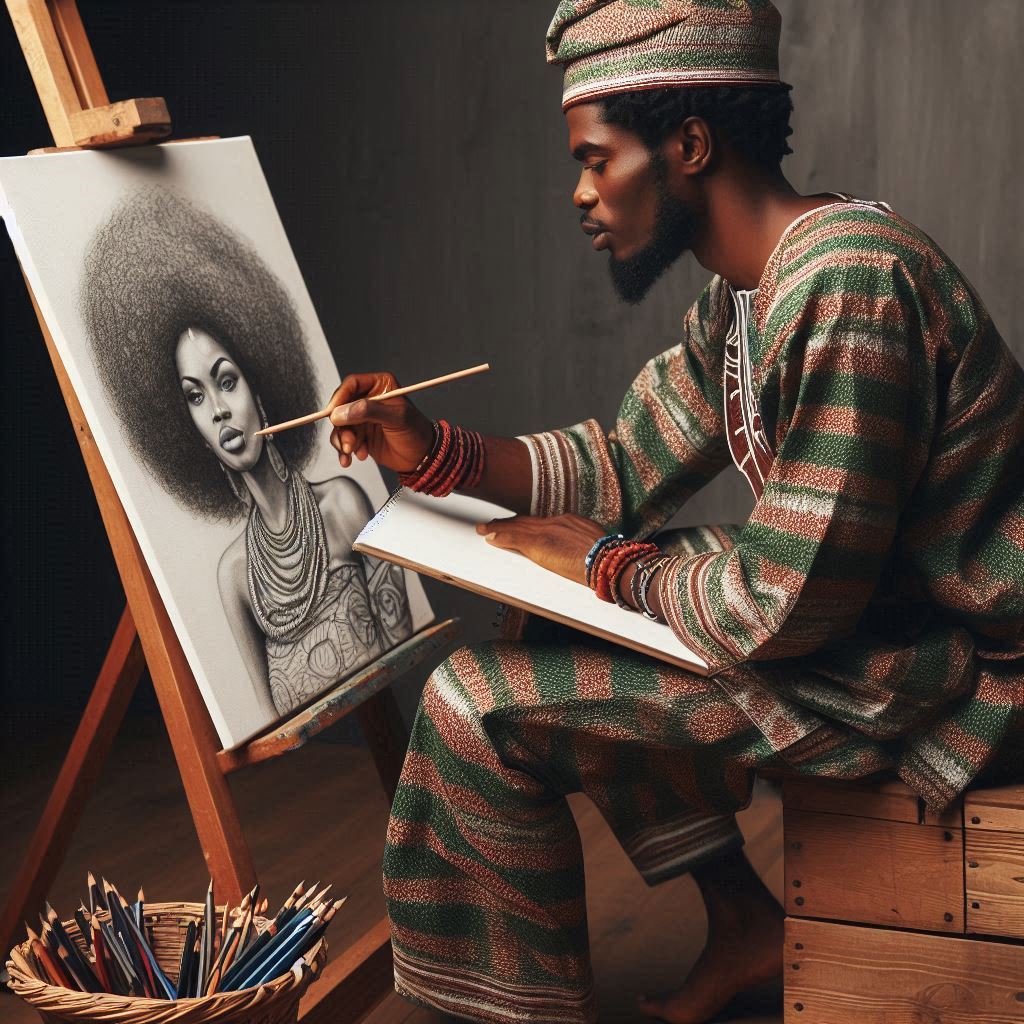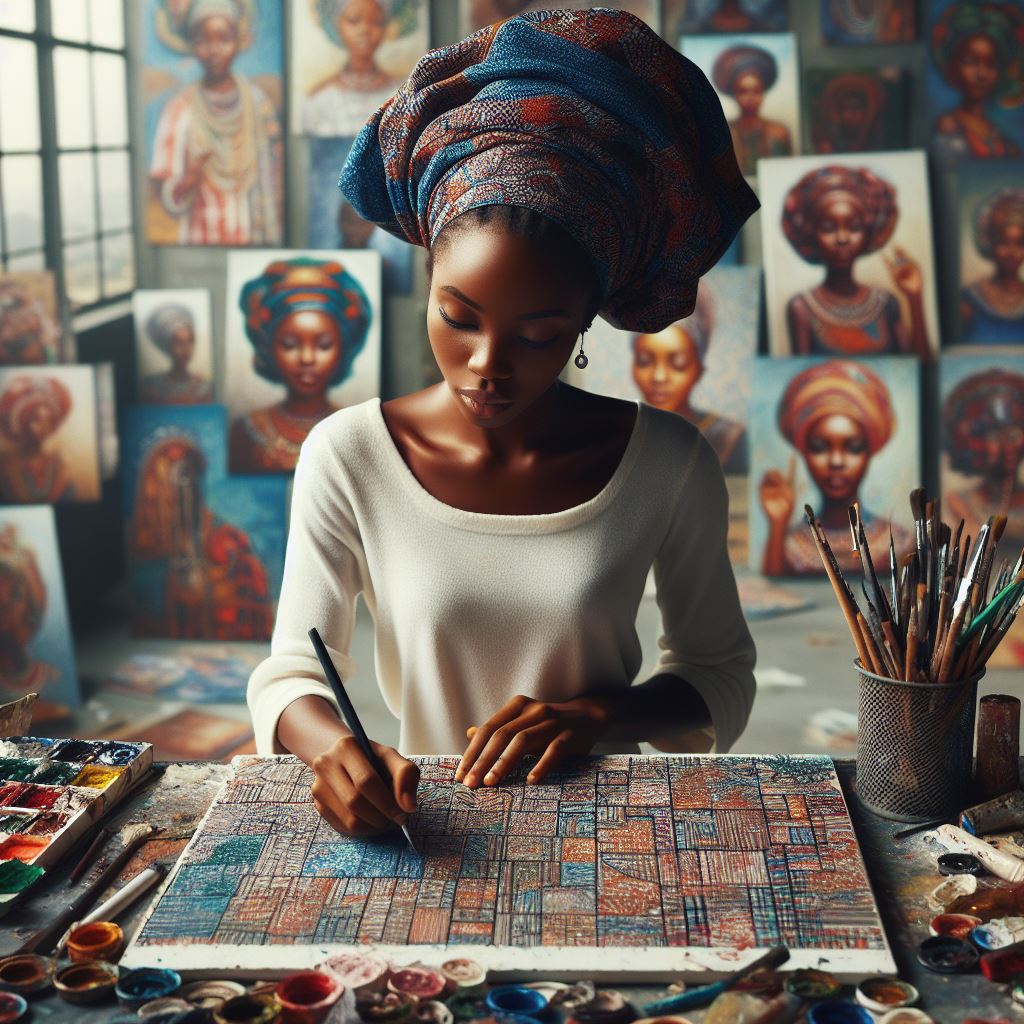Introduction
Nigerian textile art and design encompass a rich tapestry of traditions, creativity, and cultural significance.
Overview of Nigerian Textile Art and Design
- Diverse Techniques: Nigerian textile art spans various techniques, including weaving, dyeing, and embroidery.
- Vibrant Patterns: Textiles feature vibrant colors and intricate patterns, reflecting Nigeria’s diverse cultural heritage.
- Historical Significance: Textile production has deep historical roots in Nigeria, dating back centuries.
Importance in Preserving Culture and Heritage
Nigerian textile art plays a crucial role in preserving the country’s culture and heritage.
- Cultural Identity: Textiles serve as symbols of cultural identity, representing different ethnic groups and traditions.
- Intergenerational Transmission: Artisans pass down traditional techniques and designs from generation to generation, ensuring their preservation.
- Community Connection: Textile production often involves community collaboration, strengthening social bonds and collective identity.
- Economic Empowerment: Textile art provides livelihoods for countless artisans and contributes to Nigeria’s economy.
- Global Recognition: Nigerian textiles have gained international acclaim, showcasing the country’s artistic prowess on the global stage.
In essence, Nigerian textile art and design are more than just fabric; they are repositories of history, culture, and creativity. They continue to inspire and enrich both local communities and the wider world.
History of Nigerian Textile Art and Design
The evolution of Nigerian textile art has a rich history that dates back to ancient times.
Overview of the Evolution
- Over the centuries, various cultures and traditions have influenced textile art in Nigeria.
- AncientThrough generations, artisans have passed down ancient techniques like weaving, dyeing, and embroidery, preserving them for future use.
- Artisans in Nigeria primarily crafted textiles for clothing, home decor, and ceremonial functions, showcasing their cultural significance.
Influence of Traditional Techniques and Motifs
- Nigerian textile art often incorporates traditional motifs and symbols that hold cultural significance.
- Adire, a traditional Yoruba indigo-dyed cloth, is an example of a textile with deep cultural roots.
- The use of handwoven fabrics like Aso Oke showcases the intricate craftsmanship of Nigerian artisans.
Introduction of Modern Design Influences
- In recent years, Nigerian textile artists have embraced modern design influences to create contemporary pieces.
- Global trends in fashion and art have inspired Nigerian designers to experiment with new techniques and styles.
- Collaborations with international designers have helped Nigerian textile art reach a wider audience on the global stage.
Overall, the history of Nigerian textile art and design reflects a blend of traditional techniques and modern influences that continue to shape the vibrant and diverse textile landscape in Nigeria.
Read: Day in the Life of a Nigerian Beauty Therapist
Major Textile Art Techniques in Nigeria
Nigeria expresses its rich cultural heritage through various textile art techniques like adire, aso oke, and akwete.
Description of Popular Techniques
- Adire: Adire is a traditional Nigerian textile art technique that involves resist dyeing on locally woven cotton cloth. The patterns created are intricate and unique, often reflecting elements of Yoruba culture.
- Aso Oke: Aso oke is another popular textile art technique in Nigeria, particularly among the Yoruba people. It involves weaving colorful and patterned cloth typically used for special occasions like weddings, festivals, and ceremonies.
- Akwete: Akwete is a textile art technique originating from the Igbo people in southeastern Nigeria. It involves hand-weaving on a traditional loom to create vibrant and detailed fabrics used for clothing and accessories.
Weaving, Printing, and Dyeing Methods
- In Nigerian textile art, weaving plays a fundamental role. Artists interlace yarns to create fabric, achieving diverse patterns and designs.
- Printing: Printing is another common technique in Nigerian textile art, often done through block printing or screen printing. This method allows for intricate designs to be transferred onto fabrics, creating visually appealing patterns.
- Dyeing: Dyeing is a crucial part of Nigerian textile art, especially in techniques like adire. Natural dyes are commonly used, derived from plants, roots, and other organic sources, resulting in rich and earthy colors on the fabric.
Examples of Textiles Produced Using These Techniques
- Adire: Examples of textiles produced using the adire technique include adire eleko, which features hand-painted designs using cassava starch as a resist agent.
- Aso Oke: Aso oke fabrics are often used for making ceremonial outfits such as gele (headtie) and iro ati buba (wrapper and blouse).
- Akwete: Akwete fabrics are known for their intricate patterns and are used to make traditional garments like wrappers, skirts, and blouses.
These major textile art techniques in Nigeria showcase the creativity and skill of artisans in the country, preserving cultural traditions and creating unique and beautiful textiles appreciated both locally and internationally.
Read: Cosmetology and Beauty Therapy Scholarships in Nigeria
Significance of Textile Art in Nigerian Culture
Textile art plays a significant role in Nigerian culture for various reasons:
Role of textiles in ceremonies and celebrations
Textiles are often used to convey status, wealth, and cultural heritage during special occasions like weddings, festivals, and ceremonies.
They serve as a form of communication and can symbolize the importance of the event or the individuals involved.
Special fabrics like Aso-oke, Adire, and Ankara are commonly worn during traditional ceremonies to showcase cultural pride and identity.
Symbolism and meaning behind textile patterns and designs
Each textile pattern and design in Nigeria carries rich symbolism and meaning that reflects the cultural values and beliefs of different ethnic groups.
For example, the use of geometric shapes, animals, and motifs in Adire textiles often represents spiritual beliefs or historical events.
Color choices also play a vital role in conveying messages, with red symbolizing vitality, white representing purity, and blue signifying peace.
Connection between textile art and identity
In Nigerian culture, textiles are closely linked to individual and communal identities, serving as markers of belonging and heritage.
Through the wearing and display of specific textiles, people can express their affiliations, social status, and cultural affiliations.
Textile art has the power to reinforce a sense of unity and pride within a community, connecting individuals to their shared past and traditions.
Read: Exploring Semiotics in Communication Arts

Explore Further: Understanding Film and TV Production Roles in Nigeria
You Might Also Like: The Role of Culture in Nigerian Fashion Design
Contemporary Nigerian Textile Designers
In recent years, Nigeria has seen a surge in talented textile designers who are making a mark both locally and globally.
These designers are not only preserving traditional Nigerian textile art but also infusing modern trends and techniques to create innovative designs that appeal to a wide audience.
Profiles of Prominent Nigerian Textile Designers
One of the most well-known Nigerian textile designers is Amaka Osakwe, the creative force behind the brand Maki Oh.
Osakwe is known for her hand-dyed fabrics and intricate beadwork, which have garnered international acclaim.
Another notable designer is Adebayo Oke-Lawal, who founded the brand Orange Culture. Oke-Lawal blends traditional Nigerian textiles with contemporary silhouettes to create unique and avant-garde pieces.
Other notable Nigerian textile designers include Ituen Basi, known for her bold prints and vibrant colors, and Duro Olowu, whose mixed-print designs have been worn by celebrities around the world.
These designers are at the forefront of Nigeria’s burgeoning fashion industry and are paving the way for the next generation of talent.
Exploration of Their Innovative Designs and Techniques
Nigerian textile designers are known for their use of bold colors, intricate patterns, and diverse textures. Many designers incorporate traditional Nigerian fabrics such as adire, ankara, and aso-oke into their collections, giving a modern twist to these age-old textiles.
Some designers also experiment with techniques such as tie-dye, batik, and embroidery to create one-of-a-kind pieces that stand out in the global fashion scene.
One of the key innovations in Nigerian textile design is the use of technology to create cutting-edge fabrics and prints. Designers are now using digital printing and 3D printing to bring their designs to life, pushing the boundaries of what is possible in the world of textiles.
This infusion of technology with traditional craftsmanship has set Nigerian designers apart on the international stage.
Impact of These Designers on the Global Fashion Industry
Nigerian textile designers have had a significant impact on the global fashion industry, bringing a fresh perspective and unique aesthetic to the table.
Their bold and vibrant designs have caught the attention of fashionistas and celebrities worldwide, with many designers showcasing their collections at top fashion weeks like New York, London, and Paris.
These designers have also put Nigerian fashion on the map, attracting interest from fashion buyers, editors, and influencers from around the world.
By staying true to their cultural roots while embracing innovation, Nigerian textile designers have carved out a niche for themselves in the competitive fashion landscape, proving that African fashion is not only relevant but also influential on a global scale.
In essence, contemporary Nigerian textile designers are making waves in the fashion industry with their innovative designs and techniques.
By staying connected to their heritage while pushing boundaries, these designers are reshaping the perception of African fashion and establishing themselves as key players in the global fashion scene.
As their influence continues to grow, we can expect to see even more exciting and boundary-pushing designs from Nigerian designers in the years to come.
Read: Research Areas in African and Asian Studies
See Related Content: How to Excel in Mass Communication Studies Nigeria
Challenges Facing the Nigerian Textile Industry
When it comes to the Nigerian textile industry, there are several challenges that hinder its growth and development. These challenges range from lack of infrastructure and resources to the impact of globalization and fast fashion on traditional textile practices.
However, despite these obstacles, there are ongoing efforts to revitalize and support the Nigerian textile industry.
Discussion of Issues
- Lack of Infrastructure and Resources: One of the major challenges facing the Nigerian textile industry is the lack of adequate infrastructure such as reliable electricity, water supply, and transportation. This lack of infrastructure makes it difficult for textile manufacturers to operate efficiently and effectively.
- Impact of Globalization and Fast Fashion: With the rise of globalization and fast fashion, traditional textile practices in Nigeria are facing stiff competition from imported goods and mass-produced clothing. This has resulted in a decline in demand for locally made textiles.
Efforts to Revitalize and Support the Nigerian Textile Industry
Despite the challenges facing the Nigerian textile industry, there are ongoing efforts to revitalize and support the sector. These efforts include:
- Government Support: The Nigerian government has implemented various policies and programs aimed at revitalizing the textile industry. These include providing financial incentives, infrastructure development, and training programs for textile artisans.
- Promotion of Made in Nigeria Campaigns: To encourage the consumption of locally made textiles, there has been a push for made in Nigeria campaigns. These campaigns aim to raise awareness about the quality and craftsmanship of Nigerian textiles and promote patriotism in supporting local industries.
- Collaboration with Designers and Artisans: There has been a growing trend of collaboration between Nigerian designers and traditional textile artisans. This collaboration not only helps in preserving traditional textile practices but also allows for innovation and creativity in the industry.
- Investment in Technology and Innovation: To compete in today’s market, Nigerian textile manufacturers are investing in technology and innovation. This includes the adoption of modern machinery, digital printing techniques, and eco-friendly practices to improve efficiency and quality.
- Skills Development and Training: In order to ensure the sustainability of the textile industry, there is a focus on skills development and training programs for young artisans. This includes apprenticeships, vocational training, and workshops to transfer traditional knowledge and skills to the next generation.
In review, while the Nigerian textile industry faces several challenges, there are concerted efforts being made to revitalize and support the sector.
With a combination of government support, promotion of made in Nigeria campaigns, collaboration with designers and artisans, investment in technology and innovation.
And skills development and training, the Nigerian textile industry has the potential to thrive and compete in the global market.
Conclusion
Understanding Nigerian textile art and design is crucial for several reasons:
- Cultural Preservation: It preserves Nigeria’s rich cultural heritage for future generations.
- Artistic Expression: Textile art allows artists to express their creativity and cultural identity.
- Economic Impact: The textile industry contributes significantly to Nigeria’s economy, providing employment and income.
- Global Recognition: Appreciating Nigerian textile art promotes cultural exchange and enhances Nigeria’s global reputation.
We must appreciate and support the preservation of these cultural traditions:
- Promote Awareness: Educate others about the significance of Nigerian textile art and its impact.
- Invest in Artists: Provide resources and opportunities for Nigerian artists to continue their craft.
- Collaborate: Foster partnerships between artists, designers, and organizations to promote Nigerian textiles internationally.
- Celebrate Diversity: Embrace the diversity of Nigerian textile traditions and celebrate their beauty and significance.
By valuing and supporting Nigerian textile art and design, we contribute to the preservation of cultural heritage and the enrichment of global artistic expression.




